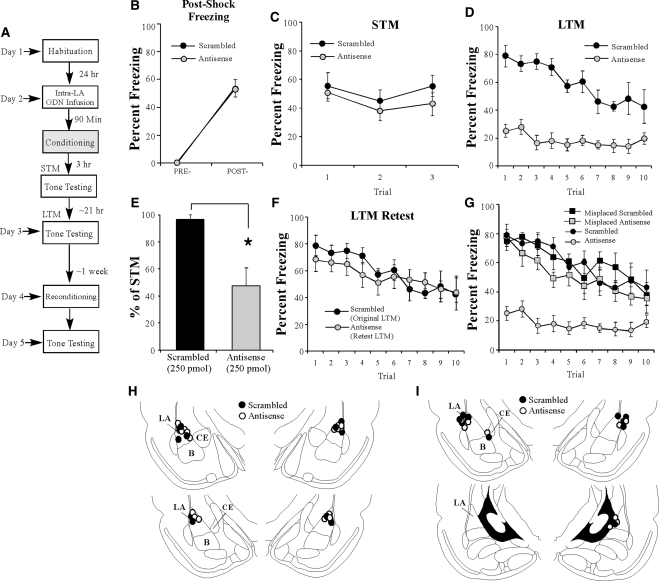Figure 3.
Antisense knockdown of EGR-1 protein in the LA impairs auditory fear memory consolidation. (A) Schematic of the behavioral protocol. Rats were given intra-LA infusion of either EGR-1 antisense (n = 9) or scrambled (n = 6) ODN (250 pmol; 1 µL/side) 90 min before fear conditioning. STM was examined in a distinct context 3 h later and LTM was examined 24 h after the conclusion of training. (B) Post-shock freezing in each group immediately after the conditioning trial. (C) Auditory fear memory assessed at 3 h after fear conditioning for each group across all three tone presentations. (D) Auditory fear memory assessed 24 h after fear conditioning for each group across all 10 tone presentations. (E) LTM depicted as a percentage of STM for each rat in each group. *P < 0.01 relative to the scrambled group. (F) Antisense-infused rats were retrained in the absence of ODN infusion 1 wk later and retested 24 h later. Here, freezing scores for the retrained antisense rats are depicted together with those of the scrambled rats used in the initial LTM test. (G) Auditory fear memory assessed 24 h after fear conditioning across all 10 tone presentations for misplaced antisense (n = 6; gray squares) and scrambled (n = 5; ▪) groups. Here, misplaced rats in each group are depicted together with the well-placed antisense (gray circles) and scrambled groups (•) from the initial LTM test. (H) Histological verification of intra-LA (well-placed) cannula placements for rats infused with either antisense (○) and or scrambled (•) ODNs. (I) Histological verification of cannula placement for misplaced rats. Panels adapted from Paxinos and Watson (1998) and reprinted with permission from Elsevier © 1998.

